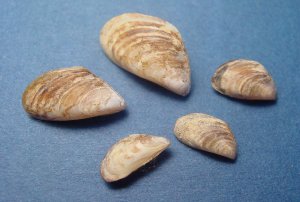Quagga Mussels on the Lower Colorado River
Quagga Index
Main Program Page
Reclamation Quagga and Zebra Mussels website
History and Background
Prevention Activities
Hoover Dam
Davis Dam
Parker Dam
Imperial Dam/Yuma Area
Research & Testing
Photo Gallery
In January 2007, quagga mussels, a thumbnail-sized invasive species from Eastern Europe, was discovered at Lake Mead. The discovery generated instant concern, as these mussels can potentially colonize water supply systems at hydroelectric power plants and similar facilities to the point of disrupting operations.
The Bureau of Reclamation's Lower Colorado Basin immediately embarked on a concerted effort to learn more about these mussels and their potential impacts to this region. The objectives were twofold: to ensure the mussels did not affect power generation or water delivery operations at Hoover, Davis and Parker dams; and to gather information that could be shared with other organizations about the mussels, their potential impacts, and methods of preventing or combating those impacts.
Throughout 2007, Reclamation conducted literature searches, inspected its facilities, established partnerships with other water utilities in the Lower Colorado River Basin, conducted a sampling program to determine the density of mussel larvae in Lake Mead and Lake Mohave, and supported public outreach efforts.
Reclamation also initiated further assessment of Hoover Dam and Davis and Parker Dams, and for recommendations of possible methods of preventing or controlling infestations on critical operating systems.

As a result of this effort, the Region has implemented specific control measures at:
In addition, Reclamation's Research and Development Office in Denver and other agencies are conducting further research and testing new quagga mussel prevention methods at these dams and other facilities.It may not be possible to eradicate the mussel from the Colorado River system, but, working in partnership with others, the Lower Colorado Region is taking steps necessary to ensure Reclamation hydroelectric facilities continue to provide water and power to the Southwestern United States.
For more information please contact Thomas Ashley at tcashley@usbr.gov or 702-293-8365.

